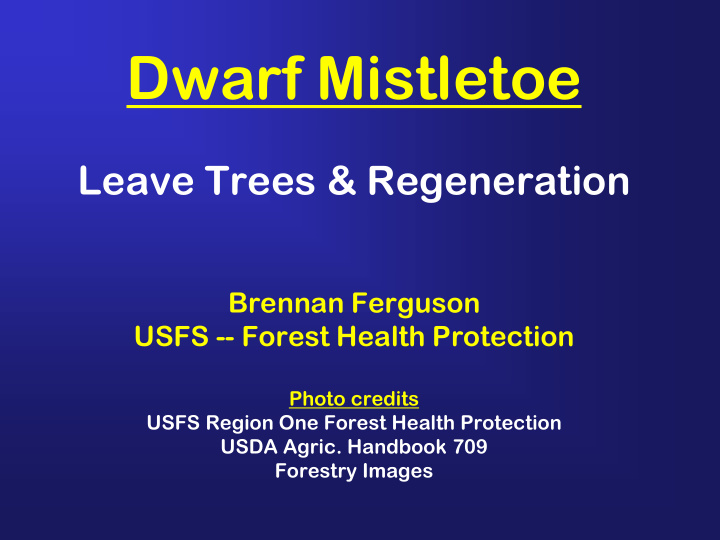



Dwarf Mistletoe Leave Trees & Regeneration Brennan Ferguson USFS -- Forest Health Protection Photo credits USFS Region One Forest Health Protection USDA Agric. Handbook 709 Forestry Images
Dwarf Mistletoe Biology • Genus Arceuthobium; found only on conifers. • Parasitic plants with leaves reduced to small scales; produce only a fraction of their own photosynthate - the rest comes from the host. • Cause a disease by extracting water and nutrients from host, thus disrupting normal physiology.
Dwarf Mistletoe Biology • Numerous dwarf mistletoe species, each specializing on different conifer species. • Dwarf mistletoes are obligate parasites …when the tree dies, the mistletoe dies!
Impacts of DM Infection • Decreased height & diameter growth, particularly as infection severity increases. • Reduction in host’s cone & seed crops; also evidence of reduced seed germination. • Top-kill and mortality. • Where seral species are infected there can be an accelerated shift in succession towards more tolerant spp.
Effect of larch DM on growth – No infection vs. heavy infection Pierce 1960
Ecological Considerations • Witches brooms provide nesting and hiding habitat for birds and mammals. • Seeds, plants, and host tissue provide forage for birds, squirrels, porcupines, and specialized insects. • Infections add complex structure to the forest.
Brooms caused by dwarf mistletoe
Dwarf mistletoe seed dispersal
10-30’ outward
Dwarf mistletoe seed photos by R.F. Scharpf
Spindle-shaped swelling forms at infection site
Simplified life cycle on lodgepole pine Six years from time seed lands till more seed is produced.
Evidence of infection •Branch swellings •Mistletoe plants
Evidence of infection •Broom formation
Evidence of infection • Plants • Basal cups
Evidence of infection •Bole canker * Check for DM plants growing from suspected stem cankers. * Mainly found on western larch and lodgepole pine.
Host Susceptibility Ratings • Primary host • Secondary host – Numerous DM species, especially in this region, do not have a secondary host, so use of non-host conifers can be very important. • Occasional / Rare host
Dwarf Mistletoe Management
Hawksworth Dwarf Mistletoe Rating (DMR)
Upper Upper Mid DMR = 5 Mid Lower Lower DMR = 2
DMR - individual tree basis • DMR 1-2 = light infection • DMR 3-4 = moderate infection Growth loss • DMR 5-6 = heavy infection Top-dieback & mortality
Infected advanced regeneration
Western larch
Lodgepole pine
Ponderosa pine
Key Management Characteristics • Host specificity of DM species. • Seed spread – Averages 15-20 feet horizontally – More than 90% of seed falls within 33 feet – Less than 5% of seeds result in infections. • Life cycle is usually 5-6 years from infection to seed production. • Latent infections - No visual evidence but they are established!
Potential Management Options • Do nothing different if that fits your objectives. • Convert to existing non-host species – E.g. Douglas-fir to ponderosa pine. • Clearcut followed by sanitation – Removes residual infections before stand establishment.
Potential Management Options • Seed tree or shelterwood cuts followed by overstory removals after regeneration is established. • Partial sanitation cuts to reduce infection levels in stand – Least desirable but may be necessary if no other options.
Example 1: Western Larch • DM is the most damaging disease of western larch. • We often prefer to maintain larch on the site (due to root disease, et al.) and to retain a seral component. • How can we do so and not have the subsequent stand severely impacted?
Decisions Are there enough DM = 1-3 trees left to manage? Will infected trees produce enough seed?
Will sanitation thinning serve to reduce infection levels?
• Achieving natural regeneration and minimal infection (Mathiasen 1998) – Select seed trees with lowest DMR’s (0-3’s). – Remove larch seed trees before regeneration is 7 years-old or 1.5m (~5’) tall. – Utilize PCT or “daylighting” treatment to remove as many infected trees as possible several years after overstory removal. (Wait for latent infections to show themselves.) – Mathiasen (1998) showed that most infections occur within ~40’ of seed trees.
Infected overstory infects the regeneration
Infected overstory is removed, then infected regeneration several years later.
Regeneration grows with acceptable infection
Example 2: Lodgepole pine • DM is the most damaging disease of lodgepole pine. • Typical approach to regenerating lodgepole is clearcutting, but may be desire to leave groups. • How can we minimize infection in subsequent stand?
Dwarf mistletoe in residual trees!
Example 2: Lodgepole pine • Post-harvest: Slash all infected, non- merchantable trees. • Minimize “edge” effect – Utilize roads and other barriers to provide buffer between adjacent, infected stands. – Use “roundish” cutting units, not narrow strips.
Clearcut followed by “sanitation”
Create buffer between taller, infected trees and regenerating stand
Example 3: Douglas-fir and ponderosa pine Utilize host / non-host: Douglas-fir mistletoe does not infect ponderosa pine … so plant pine to your heart’s content immediately around a mess like this … … or larch if the site is suitable.
Summary • Dwarf mistletoes can be managed via silvicultural treatments & careful planning. • Spread and intensification are minimized in well-stocked, even-aged, mixed-species stands. • Which stand characteristics promote DM? – Infected overstory above regeneration of same species.
Summary • Stands with infected overstory should receive the highest management priority, particularly (absolutely) if a regeneration treatment is planned. • When you need to retain some infected trees, remove heaviest infections first. • Follow-up sanitation thinning to remove trees that had latent infections.
Recommend
More recommend